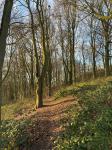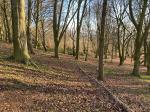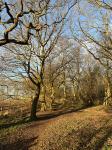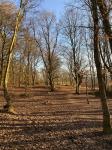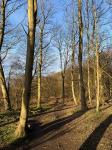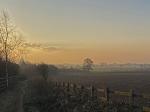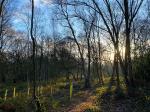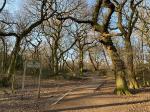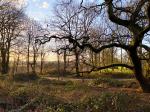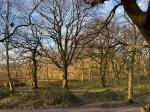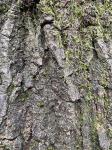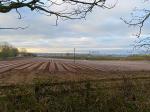Brayton Barff Through the Seasons.
Set in the Vale of York, South West of the market town of Selby and between the villages of Thorpe Willoughby and Brayton, lies Brayton Barff, a sandstone Hill approximately one hundred and fifty feet in height which was formed by glacial movement during the last Ice Age. It is a significant landmark in an otherwise flat landscape.
Today the site is primarily owned by Yorkshire Water with Selby District Council owning a small patch of the land adjacent to the A63 Selby bypass. A large underground reservoir occupies the centre of the site which delivers water to around 4.7 million customers throughout Yorkshire.
Within the Barff woodland over 40% of the trees are Sessile Oak which are generally found in semi natural woodlands in the north of the country. These trees are so called because its acorns are not held on stalks, like those of the English Oak (Pedunculate), but attached directly to the outer twigs. There are also several English Oak trees as well as some cross-hybrid oaks. These trees are known to support many species of flora and fauna, invertebrates, mosses, lichen and fungi.
During the Victorian times it is thought that the shipbuilders on the east coast would come over to the Barff for selected cuts of timber to build their sea going vessels.
The Barff also has a variety of other trees including Silver Birch, Beech, Sycamore, Holly, Rowan, Scots Pine, Alder, Hawthorne and European Larch. There are also several Yew, Willow, Hazel, Horse Chestnut and Wych Elm. As with similar woodlands there are a variety of bushes, including Honeysuckle, Elderberry, Gorse, Broom and Buddleia.
The history of Brayton Barff is quite vague, apparently during 1803 a beacon was lit on the Barff when the country was threatened with an invasion by Napoleon. In May 1935, to celebrate King George V's Silver Jubilee, a Bonfire was lit on the Barff as part of the celebrations.
Early issues of Ordnance Survey Maps dated 1903 clearly show a rifle range on the Barff, extending out to Mill Lane. During the 
Between 2001 – 2004 the A63 Selby bypass, 10km twin lane single carriageway was constructed which severed the South West corner of the Barff, adjacent to Selby Golf Course and resulted in a slight redesign of several holes on the golf course. Wooden fencing was erected as a result of this new road running alongside of the Barff and a footbridge constructed over the ‘new road’ following the line of the Bridal way which extends from Mill Lane. Around 2005/2006 a definite 2metre wide limestone aggregate footpath was laid forming a circular path around the outer edges of the woodland. This footpath is approximately 1.2 miles in length and takes about 30 minutes to circumnavigate at a leisurely pace.
In 2012 the Barff was declared an Ancient Oak Woodland and as such throughout 2012 and 2013 significant work had been carried out by the relevant agencies to cut and remove large swathes of non-native trees, creating at that time huge scars on the landscape. Some three years later the planting of the native trees have become well established and are flourishing. Ongoing maintenance work on the footpath around the bottom of the Barff was completed during the Summer of 2016.
A second phase of woodland maintenance commenced during the Autumn of 2019 with the removal of many old and diseased trees and the cutting back of the Gorse and Broom bushes, especially adjacent to the ‘bypass trail’, this work continued through till March 2020 with re planting continuing into April 2020.
Brayton Barff is a popular site for walkers and bird watchers alike and a path circling the outer perimeter of the Barff makes a pleasant thirty minute walk, giving views looking over towards Selby and the village of Brayton as well as the power stations of Drax and Eggborough..jpg)
For the early risers it is a great place to see some stunning sunrises over the villages of Brayton looking towards Drax Power Station, the same with the Sunsets looking over towards Eggborough and Monk Fryston.
The Barff changes with the Seasons and every visit can reveal something new, the woodland is a haven for wildlife. Records show that since 1982 one hundred and twelve species of bird have been seen in the woodland and at least 40 of those have bred here, including Tawny Owl, Buzzard, Green Woodpecker, Spotted Flycatcher, Goldcrest and Nuthatch to name just a few. On average over 70 species of bird are recorded each year. Further details of the bird life on the Barff can be found on the Brayton Barff Group Facebook page, especially the posts from Derek Cooper. Today ‘The Friends of Brayton Barff group’ led by Derek and a small team of volunteers help keep and maintain the cleanliness of the site as well as recording the wildlife and bird sightings.
The Barff is also home to fifteen different species of mammals, including Muntjac Deer, Pipistrelle Bat, Fox, and Field Vole.
Over eighty species of plant and wildflowers have been recorded, included Bee Orchid, Northern Marsh Orchid, Wood Anemone, Marsh Ragwort, Bluebell, White Bluebell, Bittersweet and Purple and White Foxgloves. Over twenty species of Butterfly have been recorded, including Marbled White, Brown Angus, Speckled Wood, Comma and Brimstone.
During the Autumnal months fungi thrives in this woodland environment, species including Fly Agaric, Beefsteak Tree Fungi, Chicken of the Wood, Sulphur Tufts, Stinkhorn, Ink cap, Puffballs and Hoof Bracket are just some of the many varieties that can be found here.
Click on the galleries shown below to expand the albums.
March 2021
No sooner has March arrived then it has gone in what seems like a blink of an eye.
Sadly, the Covid pandemic rumbles on, though it is good to see that at the end of March over 30 million of us have received the first Covid vaccination and 4.5 million the second dose.
The first easing of the lockdown has been welcomed by many on the 29th. The evidence shows that it is safer for people to meet outdoors rather than indoors so outdoor gatherings (including in private gardens) of either 6 people or 2 households are now allowed, making it easier for friends and families to meet outside.
Following on from the easing of the lockdown, we took Meg & Gracie out to Castle Howard on Wednesday 31st, this was our first outing since the lockdown started and our first visit since last August. It was a gorgeous day, with sunshine and blue skies, the temperature during the early afternoon peaking at a 21C, the warmest day of the year so far. The Daffodils were in full bloom too which made for a lovely picture.
Our early morning walks on the Barff continued throughout the month, March started cold and dry with several overnight frosts. It has been nice not having to wear my wellington boots.
I am usually on the Barff between 6.30am - 7.00am at this time of year, unfortunately for most of the month it has been quite dull and gloomy at that time of day, with the sun not appearing till well after 10.00am some days, but on the handful of days that the sun rose early the sunlight transforms the Barff with a lovely golden hue.
The woodland is certainly greening up and as I write this note (towards the end of March) the Bluebells are just starting to come into flower. New leaf is showing on the Elderberry bushes, the Honeysuckle bushes and old Oaks are well in leaf too.
The Dawn Chorus continues apace, with Robin, Song Thrush, Wren, Blackbird, Great Tit, Blue Tit and Dunnock all contributing to the sound as we make our way around the Barff. I was intrigued part way through March with a bird call I hadn’t heard for a while, after a little investigation it turned out to be a singing Nuthatch, with quite a repeating trill sound.
Chiffchaff arrived back into the woodland around the 10th March and since then their numbers have increased on a daily basis, their distinctive chiff chaff call quite distinctive above that of the Great Tits at the moment. The Greater Spotted Woodpeckers continue to make their presence known with their persistent drumming on the rotten tree trunks and branches in their search for food, most of them will be sat on eggs at the moment.
The Grey Squirrels never seem to tire, chasing each other up, down and around the tree trunks, often at breakneck speed, they never hibernate and are active all year round.
The warmer Spring temperatures are bringing out many of our woodland plants too, with Wood Anemone, Violet, Wood Sorrell, Cow Parsley emerging from under the leaf mulch on the woodland floor and by the end of the month tiny florets are showing under the sunlight.
Over the weekends I often walk both sides of the Bypass trail and off late have noticed several Grey Partridge feeding amongst the field adjacent to the golf course, several years ago the corner of this field was planted with Sunflower and since then has been left fallow and the Partridge along with Goldfinch are still feeding on spent sunflower seeds. The field on the Barff side of the Bypass has just been deep ploughed for I presume a potato crop. I like to see a nicely ploughed field, and this one certainly ticks my box, I think my passion for nicely ploughed fields must come from my grandfather on my mothers’ side who was a farmer over in Holderness, in East Yorkshire during the early part of the 1900’s.
I have enjoyed watching and listening to both Sparrow Hawk and Buzzard this month, I have only heard the Buzzard calling recently over by the golf course, but the Sparrow Hawks I have watched over the top of Tap Hill, alas the Crows tend to give them a hard time as they circle on the thermals.
I have also noticed a significant number of rabbits on the Barff this month, always scampering away from me, their little white bob tails heading off into the deep undergrowth and relative safety of the bramble bushes, which too have started to grow at an alarming rate of late, often I have returned home with scratches on the back of my hands.
This last week several Blackcaps have just returned to the Barff, their numbers increasing throughout the week, and hopefully more will arrive over the next few weeks, though looking at the weather forecast for the beginning of April their passage from Southern Europe may be somewhat delayed by the Artic blast being predicted soon.
As the month comes to a close, it is nice to see the Wood Sorel, Wild Garlic and Lesser Celandine beginning to flower. I am looking forward to April, the longer days, more sunshine and most of all watching the Bluebells come into flower.
|

